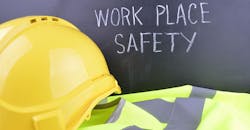Unsafe Conditions Around De-Energized Equipment, Part 4
Just because equipment is de-energized and locked/tagged out doesn’t mean it’s safe to work on.
Have you considered these hazards, for example?
- Sharp edges. Stylish work gloves are increasingly commonplace. They help protect your hands from cuts and abrasions. As with other personal protective equipment (PPE), take preventive safety measures first. Visually inspect for sharp edges on and in the equipment you’ll be working on; if you cannot modify those edges (for example, file burrs away) cover them with something.
- Poor lighting. In new construction, you might not need to deenergize equipment because there’s no power run yet. The other side of that coin is the lighting tends to be poor. It’s often poor in existing installations, too. Consider running portable lights from a generator (for general illumination) or spotlighting the work with a portable, magnetic-mount work light.
- Fire hazards. Solvents, process chemicals, product packaging, and construction materials are some of the combustibles that you may encounter because they are not where they are supposed to be.
About the Author

Mark Lamendola
Mark is an expert in maintenance management, having racked up an impressive track record during his time working in the field. He also has extensive knowledge of, and practical expertise with, the National Electrical Code (NEC). Through his consulting business, he provides articles and training materials on electrical topics, specializing in making difficult subjects easy to understand and focusing on the practical aspects of electrical work.
Prior to starting his own business, Mark served as the Technical Editor on EC&M for six years, worked three years in nuclear maintenance, six years as a contract project engineer/project manager, three years as a systems engineer, and three years in plant maintenance management.
Mark earned an AAS degree from Rock Valley College, a BSEET from Columbia Pacific University, and an MBA from Lake Erie College. He’s also completed several related certifications over the years and even was formerly licensed as a Master Electrician. He is a Senior Member of the IEEE and past Chairman of the Kansas City Chapters of both the IEEE and the IEEE Computer Society. Mark also served as the program director for, a board member of, and webmaster of, the Midwest Chapter of the 7x24 Exchange. He has also held memberships with the following organizations: NETA, NFPA, International Association of Webmasters, and Institute of Certified Professional Managers.
